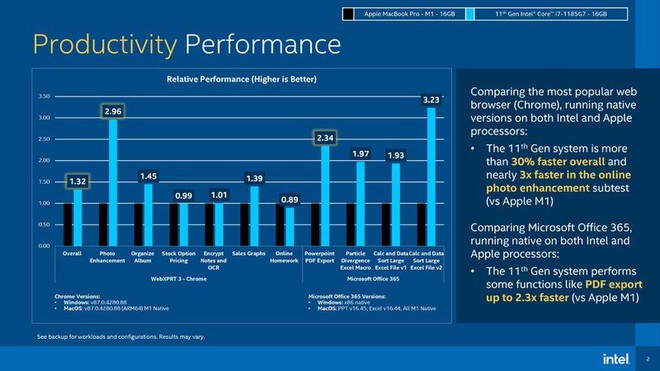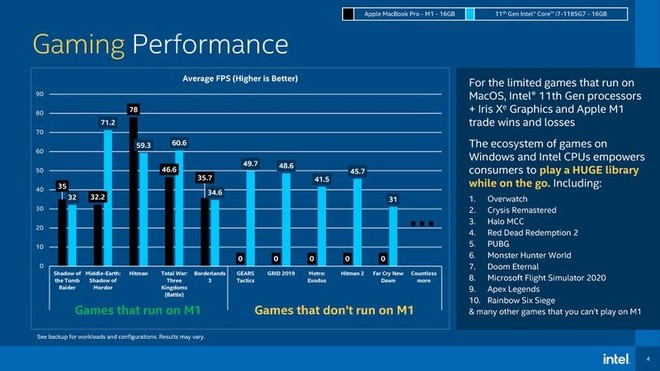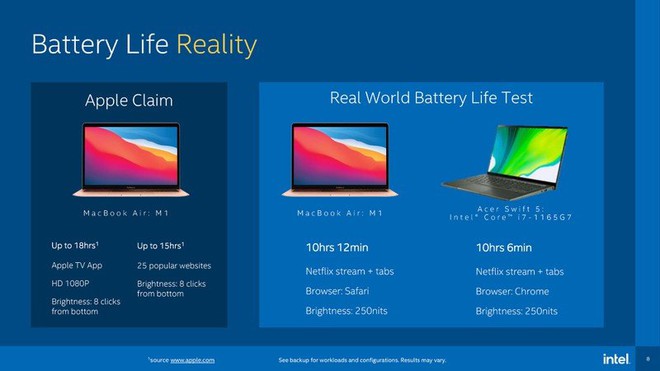It turns out that this is how Intel made Tiger Lake surpass Apple’s M1 chip: Build a separate frame of reference to have a higher benchmark than the competition.
- Tram Ho
Nearly three months after Apple released the M1-powered Macs and appreciated by both the user community and experts, Intel finally showed some signs of counterattacking.
In a recent presentation shared by PCWorld , Intel highlighted the elements described as a new kind of benchmark, in an attempt to prove that the laptop has a new 11th-generation Core processor. Most of them outperform laptops with Apple’s own designed M1 chip.
If you just read it, many people will think that it turns out that Apple’s M1 chip is … just that, when there are too many points to be inferior to Intel’s new processor. However, if you pay close attention to the specific description of these criteria, users will soon realize they are “benchmarks” that are carefully built and manufactured, even minor. and not realistically.

First, Intel says exporting a PowerPoint file as a PDF is up to 2.3x faster on a Windows laptop equipped with an 11th Generation Core i7 processor and 16GB of RAM compared to completing a task. similarly on the 13-inch MacBook Pro with the M1 chip and 16GB of RAM.
Would a user ever think he would choose one device over another, just because it converts PowerPoint to PDF faster?

Next, Intel also pointed out that Topaz Labs’ AI-based image zooming software, Gigapixel AI, also works six times faster on a Core i7 system than on the M1 MacBook Pro. But the thing is, Topaz Labs’ apps are designed to take advantage of hardware acceleration inside Intel’s processors. Obviously, you can’t take an app tweaked for your own hardware and then compare it with your competition.
In terms of gaming performance, the results vary, but Intel emphasizes and adhere to the notion that “a Mac is not ideal for gaming”, based on the notion it lacks support for “countless” games Play as Gear Tactics, Hitman 2 and some other weird listening games. The games illustrated in reality are quite “picky”, not even too popular with the majority of the gaming community.

And yet, Intel’s “shrewdness” is also demonstrated by a “real-world battery life test”, to conclude that both the MacBook Air M1 and Acer Swift 5 with Core i7 processors. The 11th generation all achieved nearly identical battery life of 10 hours while streaming Netflix with the additional tabs open. Intel says both laptops are set to 250 nits of screen brightness, with the MacBook Air running Safari and the Acer Swift 5 running Chrome for testing.
But what few people noticed is that Intel earlier, Intel used MacBoook Pro for the performance test, but quietly switched to the MacBook Air for the battery life test. Not to mention, Intel itself uses a different Core i7 processor for this test.

Apple’s website advertises the MacBook Air M1 with up to 18 hours of battery life when continuously playing back 1080p content in the Apple TV app with screen brightness set to 50% and up to 15 hours of battery life while browsing. 25 popular websites in Safari over Wi-Fi, with screen brightness also set to 50%.
Finally, Intel also added that their processors are not only superior in performance but also in choice, as they can power all types of devices from transmission laptops. systems to tablets that support features such as touch screens and also support multiple external displays. Meanwhile, the M1-based MacBook Air and the 13-inch MacBook Pro only support one external display. But in reality, these limitations can be clearly ignored with the DisplayLink adapter, albeit an unofficial solution.
“Unfriendly” benchmarks

In a comment shared on his website Six Colors, founder Jason Snell, another with a voice in the tech community, called Intel benchmarks “unfriendly” for the M1.
“The test platform was inconsistent, the arguments changed, the data was omitted and a cry filled with despair,” wrote S nell. “Current M1 processors are low-end chips for low-end systems, so Intel has only a small chance to compare itself strongly over these systems before the higher-end Macs of Apple ships and makes their job a lot harder. “
Tom’s Hardware expert Andrew Freedman also warns that all vendor benchmarks should be “extra salt”.
As for Apple, it says the M1 chip offers industry-leading performance per watt, with the latest MacBook Air outperforming the Geekbench benchmark test compared to the 16-inch MacBook Pro with Intel chips. And clearly, it’s a clear and intuitive level comparison that makes it easiest for users to imagine.
And Intel’s nightmare will continue to be heard with rumors suggesting that Apple will launch new 14-inch and 16-inch MacBook Pro models, with redesigned iMac and “more” with processors. next generation later this year.
Refer to macrumors
Source : Genk
